![]()
![]()
![]()
Use LEFT and RIGHT arrow keys to navigate between flashcards;
Use UP and DOWN arrow keys to flip the card;
H to show hint;
A reads text to speech;
138 Cards in this Set
- Front
- Back
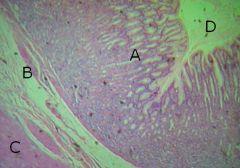
Name the layers A, B, C
|

A - Mucosa
B - submucosa C - muscularis |
|
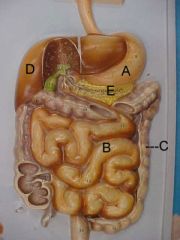
Name A, B, C, D and E
|

A - stomach
B - small intestine C - large intestine D - liver E - pancreas |
|
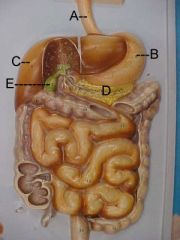
Name A, B, C, D and E
|

A - esophogus
B - stomach C - liver D - pancreas E - gallbladder |
|
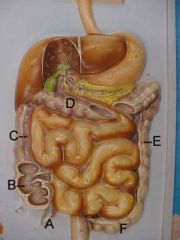
Name A, B, C, D, E and F
|

A - appendix
B - cecum C - ascending colon D - transverse colon E - descending colon F - sigmoid colon |
|
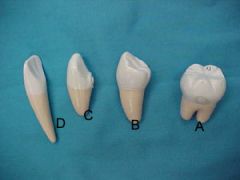
Name A, B, C and D
|

A - molar
B - canine C - premolar D - incisor |
|
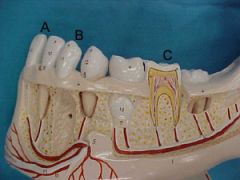
A, B and C
|

A - incisor
B - canine C - molar |
|
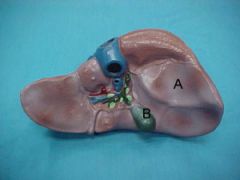
Name A and B
|

A - liver
B - gallbladder |
|
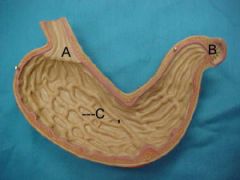
Name A, B and C
|

A - lower esophageal sphincter
B - pyloric sphincter C - rugae |
|
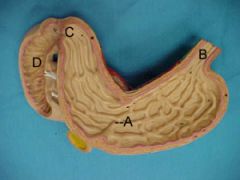
Name A, B, C and D
|

A - stomach
B - lower esophageal sphincter C - pyloric sphincter D - duodenum of small intestine |
|
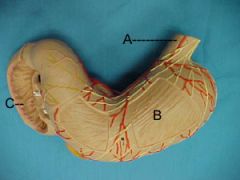
Name A, B and C
|

A - esophagus
B - stomach C - duodenum of small intestine |
|
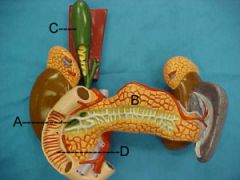
Name A, B, C and D
|

A - common bile duct
B - pancreas C - gallbladder D - duodenum of SI |
|

Name A, B, C (1 and 2) and D
|
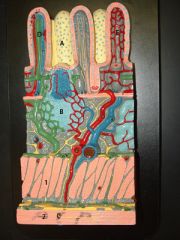
A - mucosal layer (villus)
B - submucosal (peyers patches) C - muscularis layer (circular/longitudinal layer) D - lacteal |
|
|
What are the two major processes of digestion?
|
mechanical and chemical
|
|
|
What are major features of mechanical digestion?
|
breaks things into smaller pieces, does not break chemical bonds, mastication/segmentation/peristalsis/digestive aides
|
|
|
What is segmentation?
|
muscular movement in SI – alternating forward/backward movement
|
|
|
What is peristalsis?
|
wavelike rhythmic movements in GIT
|
|
|
What are the major features of chemical digestion?
|
chemical bonds broken by enzymes, results in smaller compounds until they are small enough to be absorbed, enzymes are regulated by hormones
|
|
|
What are the organs of the digestive system?
|
mouth, esophagus, stomach, small intestine, large intestine, rectum and anus
|
|
|
What are the accessory structures of the GIT?
|
teeth/tongue, liver/gallbladder, pancreas, salivary glands, pancreas
|
|
|
Where does carbohydrate digestion begin/how?
|
in the mouth with salivary amylase (enzyme)
|
|
|
Does any digestion happen in the esophagus?
|
no
|
|
|
Where does protein digestion begin/how?
|
in the stomach with pepsin (enzyme)
|
|
|
What is pepsinogen, is it a hormone or an enzyme, where is it found and what secretes it?
|
pepsinogen is the precursor to pepsin, it’s an enzyme, it’s found in the stomach and it’s secreted/produced by the chief cells in the stomach
|
|
|
Where is HCl found, is it a hormone or an enzyme, what is it/what does it do and what secretes/produces it?
|
HCl is found in the stomach, it’s neither a hormone or an enzyme - it’s a digestive aid, it activates pepsinogen turning it into pepsin, it’s secreted by parietal cells in the stomach
|
|
|
What is gastrin a hormone or an enzyme, where is it found, what are its targets?
|
gastrin is a hormone, it is found in the stomach, it’s targets are the cardiac sphincter/(LES lower esophageal sphincter), pyloric sphincter, ileocecal valve. It closes the cardiac sphincter, and opens both the pyloric sphincter and the ileocecal valve
|
|
|
What is the major organ for digestion and absorption?
|
small intestine
|
|
|
What are the two hormones made in the SI, what do they do?
|
CCK and secretin – CCK targets the gallbladder, acini cells of the pancrease(to produce digestive enzymes) and opens the sphincter of Oddi – secretin slows down stomach contractions, stimulates the pancreatic duct to release HCO3, and stimulates the liver to make bile
|
|
|
Are large amounts or small amounts of H2O absorbed in the large intestine?
|
small amounts
|
|
|
Bile is associated with which two accessory organs?
|
gallbladder and liver
|
|
|
HCO3 is associated with what accessory organ?
|
pancreas
|
|
|
What are the four enzymes produced in the small intestine?
|
maltase, sucrose, lactase, dipeptidase
|
|
|
What are the 7 enzymes produced in the pancreas?
|
pancreatic amylase, pancreatic lipase, trypsin, chymotrypsin, carboxypeptidase, DNAse, RNAse
|
|
|
What are the three enzymes produced in the pancrease that assist in digesting proteins?
|
trypsin, chymotrypsin, carboxypeptidase
|
|
|
What pancreatic enzyme assists in digestion of carbohydrates?
|
pancreatic amylase
|
|
|
What pancreatic enzyme assists in digestion of lipids?
|
pancreatic lipase
|
|
|
What pancreatic enzyme assists in digestion of nucleic acids?
|
DNAse and RNAse
|
|
|
What are the two hormones produced in the pancrease?
|
glucagon and insulin
|
|
|
What are the three hormones produced in the stomach?
|
gastrin, histamine, serotonin
|
|
|
What controls enzymes?
|
hormones
|
|
|
On the model, number 13 is what?
|
jejunum
|
|
|
On the model, number 14 is what?
|
ileum
|
|
|
What are the pouches on the large intestine called? What is the pleural?
|
haustra/haustrum)
|
|
|
On the model, number 15 is what?
|
ileocecal valve
|
|
|
Where is the ileocecal valve found?
|
between the ileum and cecum
|
|
|
What helps the stomach expand?
|
rugae folds
|
|
|
What do the peyers patches do/where are they found?
|
pest control/defense, in the small intestine
|
|
|
What is the function of the muscularis layer of the small intestine?
|
primarily segmentation, some peristalsis
|
|
|
What do the lacteals do and where are they found?
|
they absorb and package dietary fat into chylomicrons – found in the villi of the small intestine
|
|
|
What are the blood vessels found in the liver?
|
hepatic artery, hepatic portal vein, hepatic vein, inferior vena cava
|
|
|
What are the ducts found in the liver?
|
cystic duct, common hepatic duct, common bile duct
|
|
|
Which duct comes from the gall bladder?
|
cystic duct
|
|
|
Which duct is to the left of the cystic duct?
|
common hepatic duct
|
|
|
Which duct is to the right of the cystic duct?
|
common bile duct
|
|
|
In response to ___________ the pancreatic duct secretes ____________
|
secretin, HCO3
|
|
|
Where is the sphincter of oddi found?
|
between pancreatic duct and duodenum
|
|
|
The sphincter of oddi _____________ in response to ____________
|
is relaxed, CCK
|
|
|
Specifically where in the small intestine is CCK and secretin produced?
|
duodenum
|
|
|
Specifically where in the small intestine are the enzymes sucrase, maltase, lactase and dipeptidase produced?
|
duodenum
|
|
|
What is the function of the tongue?
|
manipulates food for swallowing, contains taste buds
|
|
|
What is the function of teeth?
|
mastication of food
|
|
|
What is the function of salivary glands?
|
produces amylase and moistens food for swallowing
|
|
|
What is the function of pharynx?
|
common passageway for food and air
|
|
|
What is the function of esophagus?
|
where peristalsis begins, transports food to the stomach
|
|
|
What is the function of lower esophageal sphincter?
|
prevents acidic chime from entering esophagus
|
|
|
What is the function of stomach?
|
storage site for food, where protein digestion begins
|
|
|
What is the function of rugae?
|
increase stomach volume
|
|
|
What is the function of pyloric sphincter?
|
regulates entry of chyme into duodenum
|
|
|
What is the function of small intestine?
|
completes digestion and most of absorption
|
|
|
What is the function of villi?
|
increase surface area in SI
|
|
|
What is the function of hepatopancreatic ampulla?
|
transports bile and pancreatic juices into SI
|
|
|
What is the function of ileocecal valve?
|
allows materials from SI to enter LI
|
|
|
What is the function of large intestine?
|
forms feces, absorbs water/electrolytes/vitamins
|
|
|
What is the function of pancrease?
|
produces digestive enzymes, bicarbonate, produces hormones to regulate carbohydrate metabolism
|
|
|
What is the function of liver?
|
interconverts nutrients, produces bile, detoxifies substances like drugs/alcohol, produces plasma proteins
|
|
|
What is the function of gallbladder?
|
stores and concentrates bile
|
|
|
What transports bile and pancreatic juices into the duodenum SI?
|
hepatopancreatic ampulla
|
|
|
What are the functions of HCl?
|
activate pepsinogen/fight bacteria
|
|
|
Why are there goblet cells in the mucosa layer of the stomach that produce massive amounts of mucous?
|
to protect the stomach lining from the acidic contents
|
|
|
What are the layers of the stomach?
|
mucosa, submucosa, muscularis (oblique, circular, longitudinal), serosa
|
|
|
What type of tissue is the mucosa layer of the stomach and what else does it include?
|
simple columnar epithelial tissue/gastric glands
|
|
|
What are the parts of the small intestine?
|
duodenum, jujenum, ileum, villi, microvilli
|
|
|
In what layer of the small intestine are the intestinal glands found?
|
submucosa
|
|
|
What type of tissue is the mucosa layer of the SI made of?
|
simple columnar ET
|
|
|
Is the jejunum the upper or lower portion of the SI?
|
upper
|
|
|
The plicae circulares are found where in the body? What do they do?
|
they are found in the jejunum of the SI, they help spin food so that there is more surface area for nutrients to be absorbed
|
|
|
What tissue borders each lobule in the liver?
|
elastic CT
|
|
|
What cells in the liver produce bile?
|
hepatocytes
|
|
|
What is the hepatic portal triad made of?
|
hepatic portal vein, bile duct, hepatic artery
|
|
|
What is the biggest structure within the portal triad?
|
hepatic vein
|
|
|
What is the function of the crown of a tooth?
|
visible portion above gumline that tears, cuts, and grinds food
|
|
|
What is the function of the root of a tooth?
|
contains nerves and blood vessels for tooth
|
|
|
What is the function of an incisor?
|
adapter for cutting into food
|
|
|
What is the function of a cuspid (canine)?
|
used to tear and shred food
|
|
|
What is the function of a molar?
|
crush and grind food to prepare for swallowing
|
|
|
What is the function of a bicuspid (molar)?
|
Crush and grind food to prepare to swallow
|
|
|
Nutrients support what?
|
growth, repair and maintenance
|
|
|
Carbs are broken down into which monosaccharides?
|
glucose, fructose and galactose
|
|
|
Lipids are broken down into what?
|
3 FA’s and 1 glycerol
|
|
|
Proteins are broken down into what?
|
2 AA’s
|
|
|
Where does peristalsis happen?
|
esophagus through the large intestine
|
|
|
Where does segmentation occure?
|
small intestine
|
|
|
Where does gastric churning occur?
|
stomach
|
|
|
Where does haustral churning occur?
|
large intestine
|
|
|
Where does deglutition occur?
|
esophagus
|
|
|
Where does mastication occur?
|
tongue/teeth (oral cavity)
|
|
|
What stimulates gastrin?
|
high pH of chyme, stomach distension
|
|
|
What increases secretion of gastric juices?
|
gastrin
|
|
|
What stimulates the release of CCK?
|
partially digested proteins or triglycerides in small intestine
|
|
|
What does CCK do to the gallbladder?
|
stimulates it to contract, secrete stored bile
|
|
|
What stimulates production of secretin?
|
acidic chyme in small intestine
|
|
|
What does secretin do to the stomach?
|
inhibits production of gastric secretions
|
|
|
What is the production site, target site and action of bile?
|
hepatocytes in the liver, duodenum, emulsifies fats/enhances lipase action
|
|
|
What is the production site, target site and action of HCl?
|
stomach (parietal cells), stomach, denatures proteins/kills bacteria/activates pepsinogen
|
|
|
What is the production site, target site and action of HCO3?
|
pancreatic duct, duodenum, neutralizes acidic chyme
|
|
|
What is the production site, target site and action of mucus?
|
mucosa lining (stomach), mouth/stomach/SI/LI, neutralize, capture bugs and kills them
|
|
|
What is the production site, target site and action of saliva?
|
salivary glands (mouth), no target site, produces amylase to begin carbohydrate (starch) digestion
|
|
|
What are the three factors that affect enzymes?
|
pH environment, temperature, other chemicals (inhibitors/activators)
|
|
|
What does benedicts reagent test for?
|
presence of simple sugars (glucose (monosaccharides)/dissacharides)
|
|
|
What does IKI test for?
|
presence of starches (whole carbohydrates)
|
|
|
What is the best pH for amylase to work at?
|
pH 7
|
|
|
What effect does boiling have on amylase?
|
it deactivates it
|
|
|
What are the activation sites for amylase?
|
mouth, small intestine
|
|
|
What are the two production sites for amylase, and why?
|
mouth (salivary glands) and pancreas (pancreatic amylase) – food is sometimes swallowed too quickly, salivary amylase is deactivated in the acidic environment of the stomach so pancreatic amylase digests anything left in the less acidic environment of the small intestine
|
|
|
What is the substrate and end product of amylase?
|
polysaccharides, disaccharides
|
|
|
What is the substrate and end product of maltase?
|
disaccharide (maltose), 2 glucose molecules
|
|
|
What is the substrate and end product of sucrase?
|
disaccharide (sucrose), 1 glucose 1 fructose
|
|
|
What is the substrate and end product of lactase?
|
disaccharide (lactose), 1 glucose 1 galactose
|
|
|
What is the substrate and end product of lipase?
|
triglycerides, 3 FA’s 1 glycerol
|
|
|
What is the substrate and end product of pepsin?
|
proteins, large/medium polypeptides
|
|
|
What is the substrate and end product of trypsin?
|
large/medium polypeptides, medium/small polypeptides
|
|
|
What is the substrate and end product of chymotrypsin?
|
large/medium polypeptides, medium/small polypeptides
|
|
|
What is the substrate and end product of carboxypeptidase?
|
medium/small polypeptides, dipeptides
|
|
|
What is the substrate and end product of dipeptidase?
|
dipeptides, 2 AA’s
|
|
|
What is the substrate and end product of DNAse?
|
DNA, nucleotides
|
|
|
What is the substrate and end product of RNAse?
|
RNA, nucleotides
|
|
|
Where are the two production sites for lipase?
|
salivary lipase (submandibular/sublingual glands in mouth), pancreatic lipase (pancreas)
|
|
|
What are the optimum conditions for the digestion of fat?
|
in the presence of bile
|
|
|
What are the components of an amino acid?
|
amino group (-NH2), carboxyl group (-COOH), R group, and a middle carbon
|

